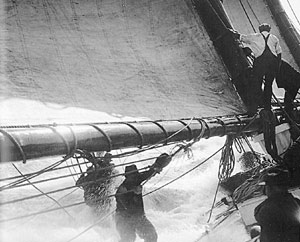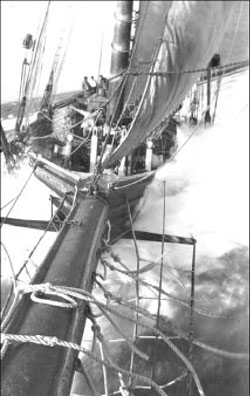 Sterling Hayden, native Mainer, schooner fisherman, race participant and actor wrote in the 1940s, "Fishermen knew what it was like to bust their guts and haul their hearts out then maybe hang to the vessel's wheel and ease her as she roared toward home and mother with her rail dragging the water, the salt spary rattling like machine-gun fire off whatever canvas might be drawing her back up under the lee of the land. F.W. Wallace photo Sterling Hayden, native Mainer, schooner fisherman, race participant and actor wrote in the 1940s, "Fishermen knew what it was like to bust their guts and haul their hearts out then maybe hang to the vessel's wheel and ease her as she roared toward home and mother with her rail dragging the water, the salt spary rattling like machine-gun fire off whatever canvas might be drawing her back up under the lee of the land. F.W. Wallace photo
|
Burgess designed the schooner Fredonia in 1889. That ship became the model for many banks and Grand Banks schooners, including the last operable Grand Banks schooner in America, the Ernestina. The Ernestina went down the ways at the James & Tarr Shipyard in Essex, Massachusetts in 1894 as the Effie M. Morrissey. It was a Fredonia style schooner, two-masted, 114’ on deck, a sparred length of 156’, a 76’ main mast, a 68’ boom, and carried 8,223 square feet of sail.
Most of these great vessels fished until the day they went down with all hands on the banks, or until they were sold down to lesser uses as barges, or tied up, tired and worn, to rot at the wharf or a remote beach. One survives, and the Ernestina has had a life, thus far, like none of the others. She drifted more than once into the near death experience that killed so many of these great ships, but just as she was about to go, a puff of salvation filled her sails.
The Effie M. Morrissey fished very successfully on the banks for decades for the Morrissey family, being refitted and refitted again. In 1905 she was sold to new owners out of Digby, Nova Scotia. During a record run from Portland, Maine to Yarmouth, Nova Scotia, when at times she reached 16 knots, she was dismasted, but made it to port. In 1914 she was sold to Harold Bartlett of Brigus, Newfoundland.
A career shift occurred when George Putnam, of Putnam Publishers, NY, sponsored an Arctic exploration. The first Arctic exploration was in 1926 when the Morrissey sailed out of New York. The Smithsonian Institution sponsored an exploration to Greenland in 1931. In 1940 the Morrissey became the first vessel to sail within 578 miles of the North Pole.
When World War II started the Morrissey became an Arctic supply and survey ship for the U.S. Navy. The Navy was surveying the north eastern reaches of North America to locate an airfield from which war supplies could be flown to Europe, avoiding the German subs that were sinking hundreds of cargo ships.
The Jackson brothers brought the ship in 1946. They planned to fit her out for inter island trade at Tahiti in the South Pacific. But in 1947 there was a fire while she was tied up in Flushing, N.Y. and her career nearly ended. However, she was raised and sold to Henrique Mendes of the Cape Verde Islands off West Africa in 1948. At this time her name was changed to Ernestina. The following year Ernestina began life as a trans Atlantic packet, shipping passengers and goods from Cape Verde to the U.S. Many Cape Verdians made their way to the U.S. aboard the Ernestina.
 The Morrisey was sold in 1948 and the name changed to Ernestina. As a trans Atlantic packet ship out of the Cape Verde Islands she regularly brought Cape Verdians to the U.S., many to the New Bedford area. The Morrisey was sold in 1948 and the name changed to Ernestina. As a trans Atlantic packet ship out of the Cape Verde Islands she regularly brought Cape Verdians to the U.S., many to the New Bedford area.
|
Sailing in heavy seas between Fogo and Santiago, Chile the Ernestina was again dismasted. A falling spar nearly killed Henrique. In 1957 she was hauled for major repairs when 28 carpenters worked for almost a month on her. Seven years later she made her last trans Atlantic voyage as a packet. But she was kept busy between 1965 and 1970 carrying cargo and passengers between Mindelo, Brava, Sao Nicolau and other South American ports.
On the way to a bicentennial in 1976 at Cape Verde, she was dismasted a third time and had to be towed to Cape Verde. The following year efforts were organized to raise money to restore the ship. The Republic of Cape Verde began the restoration. The fundraising continued through the efforts of Pete Seeger and LA Dodger Davey Lopes.
In 1982 the people of Cape Verde presented Ernestina to the people of the U.S. After more restoration in 1984 she began her fourth career as a sailing school ship and historical museum. National Historic Landmark status was gained in 1990, in 1992 she went to New Bedford, and in 1994 began her second century.
During the Tall Ships 2000 events, Ernestina sailed from Chesapeake to Nova Scotia. She is now in Maine at the Boothbay Harbor Shipyard for major repairs funded by various grants.
As the oldest surviving Grand Banks schooner, the Ernestina has taken title to many lasts. She is one of two surviving Gloucester fishing schooners, the only remaining operational Fredonia style schooner, she was the last sailing ship to bring immigrants to the United States, and is the last surviving sail powered Arctic explorer.
But more than that, she has title to an important first. The Ernestina is the first to formally represent a not so distant past when hundreds of these schooners fished, when thousands of fishermen supported families, communities and businesses, when high productivity was achieved alongside sustainability. The Official Massachusetts website describes her this way: “Next to the USS Constitution, the Ernestina is perhaps the most significant surviving sailing vessel in our nation’s maritime history.”
|





